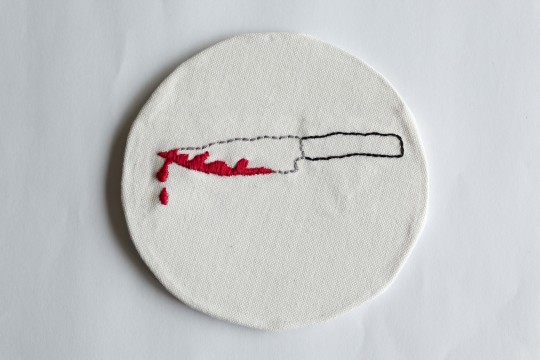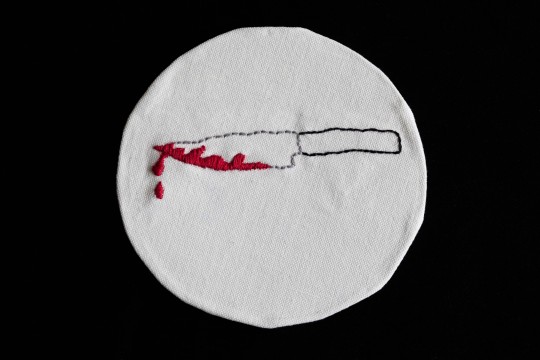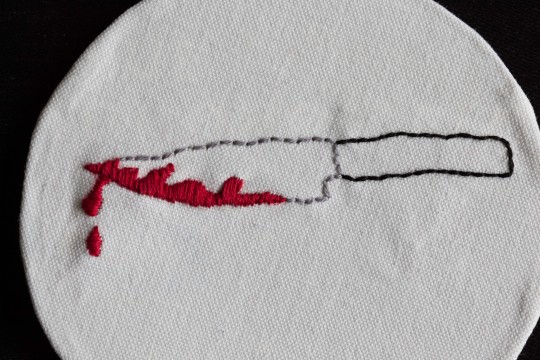#and didnt think of other analogue type arts
Text




whumptober 2022 - day 20
↳ stabbed (alt prompt)
whumpy embroidery time!
#whumptober2022#no.20#stabbed#altprompt#embroidery#fiber art#knife#blood#this was such a fun change bc first i was so stuck on wanting to do gifs or digital art or writing#and didnt think of other analogue type arts#been getting into embroidery recently and i love it#first time i did a fill stitch for the blood here actually i love how it turned out#and the texture is sensory heaven for me lmao#and i dont think ive seen much (or any? not sure) fiber arts for these challenges#would love to see more but i get its super time consuming and takes energy to learn and do and the materials cost too#but anyway i enjoyed this a lot#took the pics with my good cam and one on a black sheet and turned the shadows all the way up#so now it looks like a void lol
655 notes
·
View notes
Note
(1/2) AHHH HELLO!! I have finished network effect!! Ohhh it was SO GOOD SO SO GOOD I need to try to put all my emotional notes into a coherent message now!!
I see what you meant by all the art hints now n I’m still Yelling!! I’m so happy it’s back AHHH!! I was so worried at first when it showed up empty and the reveal that it had been deleted - the fight scene between mb and the infected humans after mb finds that out was CHILLING, and then mb’s breakdown afterwards OHH it rly sees art as a friend I am Upset!! And then when mb managed to bring art back, I felt so immediately reassured, art is so dependable!!! The banter between the two of them AS SOON as art came back im so. AHHHH I love their friendship so much!!! Their arguments rly had me alternating between laughing and clutching my chest in Pain. Art rly brings out mb’s emotional side n it’s so clear that art has come to care for mb so much too!! Ofc neither of them will admit any of this to the other tho :’DDD also their apologies after they came to an understanding… AHHH
And BIG YES to character interactions I love character interactions, it was nice to still have some of the familiar characters in this book n I also loved reading mb interacting with new characters as well!! I especially love amena so much, her playful teasing yet being supportive of mb is so good, I love their friendship :’DDD and it’s rly so cool that the series has both murder mystery type settings like in FT and the fast paced tech action scenes like in this book!! The variety is amazing!!
(2/2) Also the plot of this book was great, I rly enjoyed reading a full length novel of mb n it had everything I loved abt the previous books. It rly made me reflect abt all of mb’s character development :’) the exploitation n dehumanisation of people under capitalism, what happens when we don’t see other people as people, that is explored with mb’s introspections abt its existence n trauma n personhood, and throughout the whole plot w the abandoned colony n corporatisation of planets, while still managing to mix in great action n humour to make it a rly engaging n fun read I’m!! Yelling!! And the ending with mb feeling touched that everyone came to rescue it I am cryin!! It just shows so well that you SHOULD care abt others and it is SO GREAT!!
I rly hope there’s gonna be more books, I would love to see more of mb n art!!! Also, ur tag on the post abt recommending media!! :DDDD Thank u for posting abt this series I am SO glad I read it, n also thank u so much for yelling abt it with me!! :’)) Ahh mb is such a great character and a rly fun narrator, what an amazing series!!
YEAAAAAH
ok no believe me the whole series after AC i was Waiting for art to come back and it DID i was so happy and i didnt want to spoil you for that too bad fjhdsfsjhf but YEAH like i knew it wasnt gonna be Dead dead because like... it simply didnt make narrative sense for it to be completely dead, but oh MAN mb's reaction to it thinking art was dead? shattering. devastating. heartwrenching. very delicious in how it shows just how important they are to each other BUUUU ASSHOLE FRIENDS GET ME EVERY TIIIME mb really said

and yeah the banter between them is SO good because like. i think it really reveals things about them both that you dont see in them interacting with humans (or, in mb's case, with other bots)? because they are so singular in who they are and they dont have an absolute overlap but they're both very unique even in the world of constructs. i agree their interactions really do flip flop wildly between delightful rude bickering and punching you to the floor out of NOWHERE. you can see so much of who they are revealed in their interactions with each other in ways that their interactions with the humans don't. they both really genuinely care about each other in a way that is so unique to them (it's pretty funny but also a bit frustrating to see the humans interpret it as an analogue to a romantic relationship, because you can see where they're coming from and it works for humour purposes but also it misses so much of the nuance and the point of how they relate to each other which is that they're both Not human and consider each other as genuine equals and don't have to hold up pretenses of mimicking human behaviour to understand each other or make the other feel comfortable - i saw it somewhere as "my friend who is mentally ill in the same way i am" and it's definitely that, but also i really relate to it as an agender/aroace person and i imagine there's a lot of different ways it Can be interpreted there--anyway i'm rambling lmao) I JUST THINK THAT ART AND MB'S FRIENDHSIP!!!!!!!!
AMENA MY BELOVEEED mb sees a human and says "is anyone going to very grumpily protect this person with their life" and not even wait for an answer. i really love the mini-arc amena gets over the course of the book of coming to understand mb and its place in presaux and its position as a team member and who it is as a person ;-; and also amena herself being both very teenagerish but also incredibly adaptable and competent!! the friendship they develop over this book is really enjoyable i agree :D
YEAAAAAH EXPLORATION OF THEMES WE LOVE THAT!!! martha wells does SUCH a good job of exploring concepts of personhood and portraying mb's trauma as something both very unique and alien but also very very understandable and familiar to a lot of people in a lot of different ways and it's kind of incredible. it really is amazing to go back and reread ASR after this and see just how far mb has come and how much it's changed and grown and how much it's managed to get through and survive ;-; the change in its attitude towards itself (there's a line in NE that makes me Bonkers - "I was a thing before I was a person, if I'm not careful I could become a thing again") from where it started in ASR with grouping itself in with the equipment,,, man. the bit at the end of NE with mb realising that everyone came back to rescue it - something that only one person (mensah) had EVER done before, because mb was DESIGNED to be an expendable resource and these people who care about it said No, we aren't abandoning you, because you're a person and we care about you--MAN!!!!!! IT GETS MEEE
and YEAH the commentary on capitalism and corporate shittiness with how it's both over-the-top nightmarish and horrifically Real,,, man she writes it so well it's so good like you say with the mix of humour and the different kinds of story!! i kinda love that murderbot diaries are for the most part in the form of serial novellas because it really feels like the same kinds of media that mb loves in-universe with its serialised shows, and it allows for so many different kinds of story arcs to happen like murder mysteries and space horror and action thrillers and YEAH it's just so delightful and i really cannot wait for more to come out!! and thank YOU for sending me your delightful reviews and giving me a chance to ramble :DDD if you ever want to ramble some more (on or off anon or just dm me out of the blue!!!!!) PLEASE do i love talking about mb SO MUCH :D
0 notes
Text
Final proposal.
Whats changed/removed? why? what would you like to improve? what didnt you understand from feedback.
How has worldbuilding and immersion been adapted for creating CG and VR virtual worlds? (Extended essay, 5000 words)
The definition of worldbuilding varies according to the context in which it is used; the consensus is that it's the sub-creation of worlds and environments. This can also include the characters within the world, but for this report it will only include the environments (Forster, 2011), due to the limitation of the word count. The report will refer to worldbuilding and various other words that need defining for context:
• Virtual: worlds that are fictional in the sense that they do not exist outside of their medium(s). Within this term, fictional worlds, across many mediums, are included. This means that both written, and those created with the use of a computer, fall into this category. For example; books, games, films, animations, and other such media.
• Virtual Reality (VR): the computer-generated simulation of a three-dimensional image or environment that can be interacted with in a seemingly real or physical way.
• Sub-Creation: Wolf (2012) defines this as ‘Tolkien’s term for the building of imaginary worlds through the using and recombining of existing concepts and ideas, as opposed to the ex nihilo… creation that only god is able to do’.
The research that has already been conducted includes analogue and digital resources. A few sources that have provided insight into the topic include the documentary ‘Industrial Light & Magic: Creating the Impossible’ (Iwerks, 2010), which discusses the developments in Computer Generation (CG) which led to the change from traditional Visual Effects (VFX), and the reaction from people within the industry. The documentary focuses on the advantages to developing CG and how it opened new methods of creating effects/worlds that previously were not possible. Perhaps, there could be a similar response from developments within VR. Wolf (2012) analyses how worldbuilding extends further than the story itself, and how an audience can engage with it. Rather than giving negative or positive reactions, it focuses more on showing developments within worldbuilding. A bachelor thesis (Keo, 2017) covers the development of graphical styles in games. Similarly to Wolf (2012) the thesis doesn’t question if the developments are positive or negative, but instead shows the development in an objective fashion. It then gives an insight to the author’s own practice, and how graphical style has impacted their work. With worldbuilding being a broad definition, it could make my research harder in general.
The research so far concerns developments in the industry, as the final report will focus on the technological advancements that have impacted worldbuilding, and will intend to answer these questions: with the development of new technologies, is worldbuilding being overlooked? Are we becoming more obsessed with technological improvements, rather than the actual contents of the world? If further information is needed, surveys will be carried out to identify the general view of VR. Qualitative questions will be used for this survey, they include:
· Do you think games are becoming too obsessed with graphical improvement? Why?
· Have you ever used VR?
· How do you feel about the developments in VR?
I plan on keeping the amount of questions small, as people will be more likely to respond to less questions (Farrell, 2016). The sample size should be between 20 and 40 people: ‘a sample size of 20 as being small for a grounded theory-type approach to qualitative research and to 40 being a large sample size for the same type of study.’ (Boddy, 2016). The results from this survey will be used to support my statements, any opposing results will be used as a discussion area.
The report will prioritise worldbuilding in games, but will also explore older and newer mediums, from 'Dungeons and Dragons', to ‘VR’. It will, however, exclude fully live-action forms of worldbuilding, most notably film. That is not to say that films with CG aspects won't be referenced.
My overall aims, to answer my research question, include:
• Exploring the development in technologies used in games, film and animation, including analogue to digital variations.
• Analysing aspects of these developments in relation to a case study.
• Investigating how VR could affect worldbuilding and the immersion of it in the future.
To achieve these aims, further research is needed. For example, statistics of game sales and reviews will be gathered from ‘Steam’, ‘IGN’, Moore (2017), and other sources. In addition, I have prepared a reading list:
· ‘Hyrule Historia’ (Richardson, 2011) which covers art/graphical style for games from the Zelda franchise up to 2011.
· ‘What Happened Here’ ‘Worch, Smith, (2010), examines ‘the game environment as a narrative device, with a focus on involving the player in interpreting information, in opposition to traditional fictional exposition.’
· Walden, (2015) ‘A Living and Breathing World…’ examines ‘Dungeons and Dragons’ (N/A) and its various aspects, including the worldbuilding aspects of the game and the methodology that comes with it.
Chapter topics
Chapter One -Worldbuilding Progression
The first chapter will revolve around the developments in worldbuilding, from interactive games like 'Dungeons and Dragons' (N/A) to modern day equivalents, like those from the game developers 'Telltale' (N/A), with their 'pick-a-path' games. Immersive environments and personalised game play are the main themes.
Chapter Two- Environmental Storytelling
The essay will continue with how worldbuilding has evolved, through means of CG, by creating virtual 3D environments, and how that impacts environmental storytelling (Worch and Smith, 2010). To conclude, the chapter will provide a comparison of how industry practitioners reacted to advancements in CG, and how they could react to advancements in VR (Iwerks, 2010).
Chapter Three- Virtual Reality as a Sustainable Medium
With there being limited, well known games exclusive to VR, a comparison of sales and reviews of games that both are and aren't exclusive will be made. This takes into consideration whether a VR game needs to be backed by an existing and well-known company for it to be successful. Alongside considering VR's role in games, there should be mention of its roles outside of games. Next, chapter three should question if, as a society, we are becoming too obsessed with sensory immersion and overlooking the importance of an in-depth world, a world that is rounded verses one that is not thought out, analysing why this is and the futures of VR regarding it.
Chapter Four- Worldbuilding with Virtual Reality
The final chapter would analyse how worldbuilding and VR currently work together, using statistics from more successful games that have both in-depth worlds and rich plots. Leaving the player/viewer to infer what they can, through environmental storytelling (Worch and Smith, 2010), should also be taken into consideration, as many games use this as a form of storytelling.
When discussing this aspect of worldbuilding, a case study of 'The legend of Zelda' (Richardson, 2011) franchise will occur. With a vast background, a comparison can easily be made between the earliest to the most recent games, how they have changed in relation to what has already been discussed. This additionally refers to, trailers of the games, differences in 'formula', and graphical improvements.
In summary, I plan on conducting a series of secondary and primary research as a means to better understand developments within worldbuilding and immersion of virtual worlds. In doing so, I hope to deepen my knowledge of CG animation and its advancements with VR and other mediums. I hope to have a better understanding of how plot could be impacted by these developments, as it is an area that closely relates to my practice. I realise that this could be difficult, due to the broad topic. The final essay will not only be helpful to myself, but could also be an area of interest to fellow animators and gamers. These will be the grounds on which I will continue to work from.
0 notes